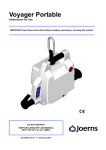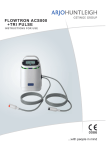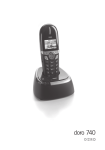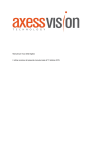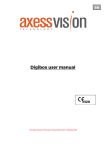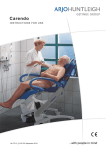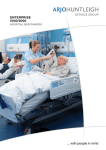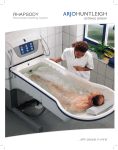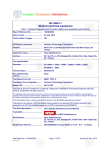Download SARA LITE - Medicaleshop.com
Transcript
SARA LITE Instructions for Use 001.20058.EN rev. 10 • March 2014 Design Policy and Copyright ® and ™ are trademarks belonging to the ArjoHuntleigh group of companies. © ArjoHuntleigh 2011. As our policy is one of continuous improvement, we reserve the right to modify designs without prior notice.The content of this publication may not be copied either whole or in part without the consent of ArjoHuntleigh. Table of Contents 001.20058.EN rev. 10 General Information ................................................................................................................... 5 Foreword.............................................................................................................................. 5 Service and Support .......................................................................................................... 5 Manufacturer Information .................................................................................................. 5 Definitions Used in this Manual ......................................................................................... 6 Operational Life ................................................................................................................. 6 Intended Use ..................................................................................................................... 6 Product Identification........................................................................................................ 6 Package Contents ............................................................................................................. 6 How to Use this Manual .................................................................................................... 6 Symbols ............................................................................................................................... 7 Safety Instructions ..................................................................................................................... 8 General Instructions............................................................................................................. 8 Shock Prevention .............................................................................................................. 8 Human and Environmental Safety Practices ..................................................................... 9 Environmental Advice........................................................................................................ 9 Battery and Battery Charger Safety Practices................................................................... 9 Homecare Environment Considerations............................................................................ 9 Part Designation ....................................................................................................................... 10 SARA LITE Floor Lift and Battery Station .......................................................................... 10 Compatible Slings .................................................................................................................... 11 Product Description/Functions ............................................................................................... 12 Hand Control: Legs Opened or Closed ........................................................................... 12 Raising and Lowering a Patient....................................................................................... 12 Correct Use of the Brakes ............................................................................................... 12 Emergency Switch-off ..................................................................................................... 12 Sleep Mode ..................................................................................................................... 13 Transferring a Patient ...................................................................................................... 13 Safety Features.................................................................................................................. 13 Automatic Cut-out............................................................................................................ 13 Automatic Stop Function ................................................................................................. 13 System Failure Lower Override ....................................................................................... 13 Foot Support.................................................................................................................... 14 Battery Charge indicator.................................................................................................. 14 Hour Meter ...................................................................................................................... 14 Lifting a Patient......................................................................................................................... 15 Using a Standing Sling....................................................................................................... 15 Battery Charging ...................................................................................................................... 17 Battery Information............................................................................................................. 17 Removing the Battery ...................................................................................................... 17 Battery Charging ............................................................................................................. 17 Care and Maintenance ............................................................................................................. 18 Preventive Maintenance Schedule .................................................................................... 18 To Be Inspected by the User ............................................................................................. 18 To Be Inspected by a Qualified Technician ....................................................................... 19 Troubleshooting ....................................................................................................................... 21 Labels ........................................................................................................................................ 22 3 Table of Contents 001.20058.EN rev. 10 Technical Specifications ......................................................................................................... Lift Dimensions ............................................................................................................... Electromagnetic Compatibility ............................................................................................... Electromagnetic Compliance .......................................................................................... Electromagnetic Emissions............................................................................................. Electromagnetic Immunity............................................................................................... 4 23 24 25 25 25 26 General Information Thank you for buying the LITE from ArjoHuntleigh. SARA Foreword Your SARA LITE is part of a series of quality products designed specially for home care, nursing homes and other health care uses. Please read this manual in its entirety. The information contained in it is crucial to the proper use and maintenance of the SARA LITE. It will help protect your product as well as ensure that the equipment performs to your satisfaction. We are dedicated to serving your needs and providing the best products available along with training that will bring your staff maximum benefit from every ArjoHuntleigh product. Lifting and transferring a person always present a potential risk. Some of the information in this manual is important for your safety and must be read and understood to help prevent injuries. Contact us if you have any questions about the use or maintenance of your ArjoHuntleigh product. WARNING: ArjoHuntleigh strongly advises and warns that only parts designated by ArjoHuntleigh should be used on products and other devices supplied by ArjoHuntleigh. Injuries can be caused by the use of inadequate parts. WARNING: Unauthorized changes on any ArjoHuntleigh product may affect its safety. ArjoHuntleigh will not be held responsible for any accidents, incidents or deficiencies of performance that occur as a result of any unauthorized changes to its products. Service and Support A service routine must be done on your SARA LITE by ArjoHuntleigh trained service staff. This will ensure the product remains safe and functional. See the “Care and Maintenance” section. Please contact your local ArjoHuntleigh agent if you need more information, want to report an unexpected event or lack of performance, or if you need any help in setting up, using or maintaining your ArjoHuntleigh SARA LITE. The agent can offer support and service programs to maximize the long-term safety, reliability and value of the product. Contact your local agent for replacement parts. Additional copies of this manual can be bought from your local ArjoHuntleigh agent. When ordering, include the Instructions for Use part number (see front page) and the product part number. Manufacturer Information This product has been manufactured by: 001.20058.EN rev. 10 ArjoHuntleigh AB Hans Michelsensgatan 10 211 20 Malmö SWEDEN 5 General Information Definitions Used in this Manual WARNING: Means: Failure to understand and follow these instructions may result in injury to yourself and others. CAUTION: Means: Failure to follow these instructions may cause damage to the product. NOTE: Means: This is important information regarding the correct use of the equipment. Operational Life The product is designed and tested for a useful life of seven (7) years or 10,000 transfers, whichever comes first. It is subject to preventative maintenance as specified in the “Care and Maintenance” section. Time equivalence between the number of transfers versus the number of years is made clear in the table below (see Fig. 1). • Has a significant need for the stimulation of his/her remaining abilities. WARNING: The SARA LITE is intended to be used for patients whose weight is within a specified safe working load. Do not attempt to lift more than the lowest weight limit indicated on the following: • the “maximum load” label on the SARA LITE; • on the sling. Surcharge of any of these elements may lead to a patient fall and to injuries. Product Identification The unit's identification number (specification, model, serial number) appears on a silver nameplate attached to the lift’s mast. Package Contents Upon receipt of the equipment, verify it against the packing list to ensure it is complete. Inspect it for possible damage due to shipping. If this the case, contact your local ArjoHuntleigh agent. How to Use this Manual Years Transfers per Day (10,000 transfers) 4 7 6 4.5 8 3.5 Fig. 1 001.20058.EN rev. 10 Intended Use The SARA LITE is a mobile raising aid, with a Safe Working Load of 175 kg (385 lb). It is intended to be used to raise patients to a standing position and to transfer them over short distances (e.g. raising from a bed and transferring to a wheelchair, or from a wheelchair to a toilet) on a flat surface. It can be used in hospitals, nursing homes or other health care facilities where the patient: • Sits in a wheelchair; • Is able to partially bear weight on at least one leg; • Has some trunk stability; • Is dependant on caregivers in most situations; • Is physically demanding for caregivers; 6 WARNING: Do not attempt to use this lift without fully understanding the information contained in this manual. A misuse of this unit may lead to a patient fall and to injuries. Keep this manual with the lift and refer to it as required. General Information Symbols General Symbols General Symbols Key to symbols Key to symbols Direct current. This symbol is accompanied by a date to indicate the date of manufacture and by the address of the manufacturer. the the This symbol indicates a type BF applied part. This symbol is accompanied by the manufacturer's catalogue number. This symbol indicates a type B applied part. This symbol is accompanied by the manufacturer's serial number. This symbol refers Instructions for Use. to This symbol locates the emergency stop system on the lift. the This symbol locates the reset switch on the lift. This symbol indicates “separate collection” for all batteries and accumulators as per the WEEE Directive. This symbol indicates a risk of pinching. SWL Safe Working Load represents the maximum load the lifter is rated for safe operation. IPN1N2 Degree of protection provided by enclosure. N1: Ingress of particles, N2: Ingress of water. Charger Related Symbol Key to symbol This symbol indicates a class II electrical equipment: term referring to electrical equipment in which protection against electric shock does not rely on basic insulation only. 001.20058.EN rev. 10 This symbol indicates products comply with medical device directive 93/42/EEC. Alternating current. 7 Safety Instructions General Instructions • Always perform the recommended daily maintenance before using the lift. WARNING: Before attempting a transfer, a clinical assessment of the patient’s suitability for transfer should be carried out by a qualified health professional. The transfer, among other things, may induce substantial pressure on the patient’s body. A transfer conducted when it should not can degrade the patient’s health condition. • Make sure special consideration is taken when transferring a patient who is connected to electrodes, catheters or other medical devices. • Always maneuver the lift by using the handle located on the mast. If necessary, initiate the movement by pushing on the back of the base with your foot. Do not push on the legs. • • • Do not push the lift at speeds which exceed a slow walking pace (3 km/hour or 0.8 meter/ second). This mobile patient lift must be used by a caregiver trained with these instructions and qualified to work with the patient. Always ensure that controls and safety features are used only in accordance with the directives specified in this manual. Never attempt to force a control or a button on the lift. • While the chassis legs on the lift can be opened to ease the transfer of a patient, they should be kept closed when the lift is in movement. • Avoid any impacts during transfer. • Any precautionary or instruction labels that cannot be easily read are replaced. 001.20058.EN rev. 10 WARNING: Do not put fingers, hands or feet where space is limited (see image below). This could pinch, cut, or cause serious harm. 8 WARNING: There is possible strangulation risks related to the hand control cable. Please take precautions to prevent these. WARNING: This product contains small parts that might present a choking danger to children if swallowed or inhaled. Do not attempt to push or pull a loaded lift over obstructions on the floor—including steps, door thresholds or moving sidewalks—if the castors are unable to travel over them smoothly. WARNING: The lift must never be operated by the patient. In the unlikely case of a failure, the patient might get stuck in the unit. • Fig. 2 CAUTION: Keep all components of the lift clean and dry to avoid a malfunction of the lift. Shock Prevention • Do not touch a damaged power cord. Electrically live equipment can result in serious injuries. If the lift or charger has any exposed or damaged wires, contact your local ArjoHuntleigh agent immediately. • Check the nameplate for voltage and cycle requirements. These requirements differ from country to country. Do not attempt to use the equipment in an area that has a different voltage and cycle requirement than what is indicated on it. CAUTION: Although the product is manufactured according to high standards, the SARA LITE and its accessories must not be left in humid or wet areas for extended periods of time. Do not spray the SARA LITE or accessories (excluding slings or ArjoHuntleigh approved wet environment equipment) with water, such as under the shower. Safety Instructions Human and Environmental Safety Practices • Should the battery casing crack and cause contents to come in contact with skin or clothing, rinse immediately with plenty of water. • If contents come in contact with the eyes, rinse immediately with plenty of water and seek medical attention. • Inhalation of the contents can cause respiratory irritation. Provide fresh air and medical attention. • For recycling and disposal of the batteries and the lift, the rules according to the WEEE directive (Waste of Electronic and Electrical Equipment) as well as local laws and regulations must be followed. If not they may explode, leak and cause personal injury. When returning batteries, insulate their terminals with adhesive tape. Otherwise, the residual electricity in used batteries may cause fire or explosion. Fig. 3 below shows the symbols for disposal and recycling. Battery and Battery Charger Safety Practices WARNING: Following the instructions is important for the safe use of the battery. • Do not expose the battery charger or connector to water. • Do not expose the battery or chargers to flames. • To avoid bodily injury, do not crush, puncture, open, dismantle or otherwise mechanically interfere with the battery. • Be careful not to drop the batteries. • Only use the charger that has been supplied with the lift. • Do not charge the batteries in an unventilated area. • The charger must not be covered or exposed to dust. Homecare Environment Considerations WARNING: The SARA LITE is not intended to be operated by children. Serious injuries could occur. Fig. 3 Environmental Advice NOTE: Rigorous cleaning actions are needed when the SARA LITE is near animals. Pet hair trapped inside castors and leg mechanism can reduce the product’s performance. 001.20058.EN rev. 10 When disposing of any items associated with the equipment, contact the appropriate local authorities for information. 9 Part Designation SARA LITE Floor Lift and Battery Station 13 14 1 16 15 2 17 18 19 6 7 3 8 9 4 20 5 3 10 21 11 22 23 12 Legend 001.20058.EN rev. 10 1) 2) 3) 4) 5) 6) 7) 8) Mast Maneuvering handle Split rings System failure lower override Rear castors with brakes Patient support arms Clip attachment points Motor/actuator 9) Knee support 10) Adjustable chassis legs 11) Foot support 12) Front castors 13) Hand control 14) Emergency stop button (red) 15) Power button (green) 16) Raise button Fig. 4 10 17) 18) 19) 20) 21) 22) 23) Lower button Hour meter Battery charge indicator Hand control connector Battery release button Battery pack Battery charger Compatible Slings ArjoHuntleigh standard sling profiles that can be used with the SARA LITE. TSS.500 SMALL RED edging TSS.503 EXTRA LARGE BLUE edging TSS.501 MEDIUM YELLOW edging TSS.504 EXTRA EXTRA LARGE TERRACOTTA edging TSS.502 LARGE GREEN edging 001.20058.EN rev. 10 Fig. 5 11 Product Description/Functions The SARA LITE is delivered to you fully assembled. Unpack the battery pack supplied, and charge it fully as described in the “Battery Charging” section. When the battery pack is fully charged, remove the pack from the charger and insert it back into the SARA LITE battery compartment. An electrical connection is made automatically. Ensure that the green button (located on the control panel above the battery) is pushed in. Hand Control: Legs Opened or Closed The base of the lift can be set with the legs opened or closed by using the two bottom buttons on the hand control (see Fig. 6). Chassis “Legs Closed” button Chassis “Legs Open” Fig. 6 Raising and Lowering a Patient Correct Use of the Brakes Foot operated brakes are fitted on both rear castors. Brakes should only be used in the following situations: • When raising the patient from a bed or chair. • When the lift and the patient are momentarily at rest; for example, while preparing for a transfer to a bed or a chair. • Whenever movement of the lift has to be halted while transferring a patient. Brakes should NOT be used in the following situation: • When lowering a patient in the lift onto a bed or chair. Leaving the brakes off allows the lift (with patient) to maintain its center of gravity throughout the transfer. Brakes application and release: • To apply the brakes, step on the back part of the pad (see Fig. 8). • To release the brakes, step on the front portion of the pad or lift it with the toe of your shoe. Brakes off Brakes on Both the hand control or the control panel can be used to operate the lift (see Fig. 7). Raise Fig. 8 Lower Raise Lower Fig. 7 While the hand control allows for more versatility, the auxiliary “Raise” and “Lower” buttons located on the control panel are secondary controls in the event the hand control stops functioning. If two buttons are pushed simultneously, the first button pushed will override all other functions until it is released. 001.20058.EN rev. 10 All functions of the lift are "hold to run". It means that movement will stop on button release WARNING: Always maneuver the lift using the handles in the travel direction indicated in the diagram above and with the lift’s chassis legs closed. This will provide maximum stability of the lift and prevent a patient fall. Emergency Switch-off The operator can shut off the power at any time by pressing the red emergency button on the control panel or by pressing the red button on the battery while pulling it backward to remove it. Reset the emergency switch-off function by pressing on the green power button or by replacing the battery (see Fig. 9). First-time users should practice the switch-off maneuver before operating the lift with a patient in it. Emergency switch-off button B Emergency release button Pull Fig. 9 12 Product Description/Functions Sleep Mode lowered by pressing the “lower” function button on the hand control. The lift is equipped with an automatic switch-off control that disables part of the circuitry to reduce energy consumption when it is not being used. When in sleep mode, the unit remains functionnal as it wakes up when a control button is pressed. Transferring a Patient If the patient is not able to grip the support arms with both hands, have someone assist you when transferring the patient. For information about how to attach a sling to the lift, read the “Lifting a Patient” section. WARNING: A patient must always be transferred with the use of a sling. This will prevent the patient from falling in case of losing grip to handle bar. WARNING: Do not attempt to maneuver the lift by pulling on the mast, boom, actuator or the patient. The lift might become unstable and lead to a patient fall. References to left or right in these instructions are as viewed from the caregiver’s pushing position, standing at the rear of the SARA LITE, facing forward Automatic Stop Function For use when lowering the patient. Great care must be taken not to lower the patient support arms onto the patient or any other obstruction, particularly when the patient is standing up and in a weight bearing position. When this occurs, the motor will continue to run but downward movement will be blocked by the obstruction. If this happens, release the “lower” button immediately and operate the “raise” button until the lift can be relocated or the obstruction can be removed. System Failure Lower Override This can be used in the event of main control failure. In the unlikely event that the hand control or control panel fails to run the SARA LITE while a patient is being transferred, lowering the patient is still possible using the system failure lower override, situated on the actuator. To use this safety feature, make sure a suitable support is underneath, ready to receive the patient, pull the slide control upwards until the patient’s own weight enables the patient support arm to slowly lower. To stop lowering the patient, release the slide control (see Fig. 11). CAUTION: This function should only be used in the event of regular control failures, and not as a regular lowering function for the product. LEFT RIGHT Fig. 10 Safety Features The following safety features have been installed: Automatic Cut-out Fig. 11 WARNING: The emergency lowering speed is proportional to the strength applied to the system override lowering device handle. If it’s pulled up with too much force, the lift may lower too quickly. This could cause serious injuries. 13 001.20058.EN rev. 10 If the equipment is inadvertently overloaded (i.e. trying to raise a patient heavier than permitted, or where the patient support arms are being accidentaly obstructed), an automatic ‘cut-out’ engages to prevent the SARA LITE from lifting the load that is in excess of the safe working load (SWL). This will stop the lifting motion automatically. If this automatic cut-out occurs, the electronics will reset when the button on the hand control is released. After that, the patient can be Product Description/Functions Foot Support Hour Meter The foot support is there to position the patient’s feet before the transfer and to support them while he/she is being raised and transferred. The hour meter (see Fig. 4) is a LCD display which shows the total duration of powered operation (in hours). This is primarily intended as an aid to service technicians and to help them calculate maintenance intervals. Battery Charge indicator 001.20058.EN rev. 10 The battery charge indicator (see Fig. 4) is a LED display, located on the battery pack holder, which shows the charge condition of the battery. 14 Lifting a Patient For more instructions about the use of various slings, refer to the instructions provided by the manufacturer of the sling, such as the ArjoHuntleigh Sling Guide. The lifting techniques described can be used for seated patients regardless of where they may be (on the edge of a bed, in a chair, a wheelchair, etc.). To fasten the support strap securely, press the buckles (if available) or velcro (if available) together. The strap must be tight, but not uncomfortable for the patient (see Fig. 14). Remember to tighten the strap once the patient has been raised from the chair. The sling may be applied before or after the SARA LITE is brought into position. 1 2 3 Fig. 14 WARNING: The sling chest support strap must always be applied and fastened to prevent a fall risk. Fig. 12 Using a Standing Sling The top of the sling can be recognized by the washing label which is located on the outside top rim of the sling. Encourage the patient to lean forward slightly to enable the sling to be placed around his/her lower back (see Fig. 13). Position the sling around the patient’s back so that the bottom of the sling lies horizontally about two inches or five centimeters above the patient’s waistline, with the patient’s arms outside the sling. Ensure that the support strap is separated and brought loosely around the body, and is not twisted or trapped behind the patient’s back. The sling support strap will help to support the patient in the sling during the lifting procedure. The strap also keeps the sling in the correct position around the patient. Position the SARA LITE in front of the patient (see Fig. 15). NOTE: Adjust the height of the patient support arms to avoid approaching the patient at eye level. Make allowances for the patient’s arms and any obstructions, such as chair arms, fixed handrails, shower grips, etc. Apply the clips to the attachment points, and fasten them securely by pulling the clips (see Fig. 12). Fig. 13 15 001.20058.EN rev. 10 Fig. 15 Lifting a Patient WARNING: Always check that all the sling attachment clips are securely connected and fully in position before and during the lifting cycle, as well as in tension as the patient’s weight is gradually taken up. Make sure each clip is attached to the correct clip attachment point on the patient support arms. Misconnected clips may lead to a patient fall. When the patient is ready, help the patient to place his/her feet on the foot support. Push the SARA LITE toward the patient to easily assist with this. If required, the chassis legs may be opened to go around a chair, by operating the appropriate hand control button. If patients can stand sufficiently well and lock their knees normally when fully raised, their knees may come away from the knee support and they will be able to lean back into the sling. Patients who can only hold on to the support grips with one hand, such as those who have suffered a stroke, can still be transferred using the SARA LITE. However, their disabled arm must be held down in front of the body while they are being helped by the caregiver (or a second caregiver). Their functioning hand holds the support grip in a normal way. Use the “Raise” button on the hand control to raise the patient to a suitable and comfortable height. The patient can be raised to a fully standing position (see Fig. 17). Carefully push the SARA LITE in closer to make full lower leg contact with the knee support (see Fig. 16). Adjust the knee support if required. Apply the foot operated rear castor brakes to keep the SARA LITE in position. Fig. 17 Now, transfer the patient to the desired location, such as the toilet, wheelchair, chair, bed, etc. Fig. 16 When raising the patient with the standing sling, the patient’s body position will go from seated to standing position. The patients’s body will be supported by the sling under the armpits, on the lower back and the chest. If the patients’s feet lift off from the foot support during the raise, lower the patient immediately until the patient’s feet are in full contact with the foot support. 001.20058.EN rev. 10 WARNING: The patient’s feet must always remain in full contact with the foot support. The lift might become unstable if part of the patient weight is not supported by the footrest plate. WARNING: To avoid a patient fall, never leave patients unattended while they are raised and standing in the lift. The transfer must be performed with the chassis legs closed, in order to allow easier maneuverability of the lift (through doorways, etc). While the patient is raised, make any necessary adjustments to clothing, incontinence pads, etc., before lowering the patient again. Use the hand control to carefully lower the patient.When lowering the patient back into a seated position, ensure that the patient is fully supported by the seat, chair, toilet, etc. WARNING: The patient’s arms must always be outside of the sling as per Fig. 17 to prevent the patient sliding out of the sling. WARNING: Great care must be taken not to lower the patient support arms onto the patient to prevent contact and injury. The patient then must hold on to the support grips with one or both hands. It may be good for the patient’s self-confidence if the patient is able to offer some assistance in standing up, providing some muscular exercise as well. Encourage the patient to give as much assistance as possible to rise from the chair and/or to steady themselves. Ensure that the patient lies back against the sling at all times. When the patient is seated, remove the sling by opening the chest support strap, then pull the clips of the sling upward to unlock them from the patient support arms. 16 WARNING: Do not attempt to release the attachment clips or the chest support strap while the patient is still being supported by the sling. This could lead to a patient fall. Battery Charging Battery Information Removing the Battery For safe handling and to extend the battery lifetime, please follow and remember these instructions. To remove a discharged battery pack, push the red button and pull straight out towards you. Replace the pack with a fully charged one from the wall mounted charging unit. CAUTION: Not following these instructions can cause short battery life. Make sure the battery belongs to the floor lift by comparing the battery label with the technical specifications in the Instructions for Use. If battery type cannot be confirmed, call qualified personnel. Battery life depends on many factors : frequency of use, frequency of charging, temperature of operation, storage and storage time. Make sure to have a replacement battery ready when needed. Do this by having additional battery packs available and keeping one charging while the other is in use. The SARA LITE uses sealed lead-acid batteries mounted to the control box. The battery pack assembly consists of two 12-volt, 4 Ah (24 volts capacity). Battery life is variable (2-3 years) and is influenced by proper charging practices and load exertion. Lead-acid battery packs are not subject to a memory effect. Therefore, they need not to be completely drained before being recharged. CAUTION: Remove the battery pack from the lift when storing for an extended period of time. Stored batteries should be recharged at least every two weeks to maximize their life span. Fig. 18 Battery Charging The battery should be recharged as soon as the charge indicator displays amber. Refer to Battery Charger Instructions for Use for charging details. Note that the battery pack may remain connected to the charger when fully charged. A discharged battery should take approximately eight hours to fully recharge. When the battery pack is fully charged, remove it from the charger, and insert it back into the SARA LITE. WARNING: Hold the battery pack firmly to ensure that it does not drop and become damaged or cause injury. NOTE: Batteries need to be charged for a minimum of 8 hours prior to initial use of this lift. To prolong the battery pack life, recharge it before it reaches a low state of battery charge, and certainly before it is totally discharged. Your lift is equipped with an audible warning device, which will make a noise when the battery charge indicator reaches the red light range. When a fully charged battery is inserted into the lift, the display will return to the green fully charged position, regardless of the level the indicator had reached previously. 001.20058.EN rev. 10 If a partially charged battery is inserted, the previous indicator level will be maintained, even though the recently inserted battery may be in a better state of charge than indicated. To achieve a true indication of battery condition, a fully charged battery must be inserted into the lift. This will reset the indicator. 17 Care and Maintenance Preventive Maintenance Schedule The product is subjected to wear and tear, and the following maintenance instructions must be acted upon when specified to ensure that the equipment remains within its original manufacturing specifications. Care and maintenance must be carried out in accordance with the preventive maintenance schedule below. Customer obligations must be carried out by qualified personnel in accordance with the instructions in this manual. WARNING: The maintenance described in the following checklist is the minimum that the manufacturer recommends. In some cases more frequent inspections should be carried out. Continuing to use this equipment without conducting regular inspections or when a fault is found will seriously compromise the safety of the user and of the patient. Service and preventative maintenance can be arranged with the manufacturer. Preventive maintenance specified in this manual can prevent accidents and reduce repair costs. WARNING: Maintenance and authorized service must be carried out by qualified personnel, fully trained in servicing procedures by ArjoHuntleigh, and equipped with correct tools and proper documentation, including Parts List and Service Manual. Failure to meet these requirements could result in personal injuries and/or unsafe equipment. To Be Inspected by the User INSPECTIONS OF THE LIFT • • • • • • • • • • • • Make sure that the split rings are correctly fastened on the actuator pivot shaft. Verify the good function of the rear castor brakes. Clean and disinfect. Ensure that the battery pack is in a good state of charge by looking at the display on the control box. Make sure that all actuator’s clevis pins and split rings are securely assembled. Carefully inspect all parts, in particular where there is close contact with the patient’s body; ensure that no cracks or sharp edges have developed which could injure the patient’s skin or become unhygienic. Check that all external fittings are secure and that all screws and nuts are tight. Check front and rear castors for hair and debris, clean when necessary. Check brake function on rear castors. Ensure that the castors are firmly secured to the chassis. The slings, the sling attachment cords, their straps and attachment clips must be checked before use with each patient. If they are damaged they should be withdrawn from use immediately and replaced. Check handset and cable. FREQUENCY Before Every Every every year week use (15h*) X X X X X X X X X X X 001.20058.EN rev. 10 * Once a year or every 15 hours recorded on the hour meter—which ever occurs first. 18 X Care and Maintenance To Be Inspected by a Qualified Technician FREQUENCY INSPECTIONS OF THE LIFT • • • • • • • • • • • • • • • • • Before every use Every week Inspect all weld sites for cracking or separation on lift and spreader bar/DPS. Make sure that all nuts and locknuts of the base open/close mechanism are securely fastened and the ball joints are in good condition. Check both mast bolts to ensure that they are tight. Verify if the pivot bolts on legs are tight. Check that the casters are securely tightened. Lubricate pivot points if necessary (use food grade type grease). Check the function of the emergency lowering device by applying weight to the lift and activating the lowering device. Make sure that the legs are perpendicular at 90 degrees to the base with the help of a square. Verify that the hole for the clevis pin has not widened. Verify that the boom is not abnormally loose in relation with the mast. To ensure that the limit stops are functioning, run the boom actuator as well as the base actuator to maximum and minimum. Press the emergency stop button and make sure that all electrical power is cut off and that the green power light is off. Check all functions of the hand control - ensure that the hand control touch pad membrane is intact. Check for the proper function of each auxiliary switch located on the control box. Verify that the batteries are in good condition and that they are not leaking. Inspect all cables. Verify the actuator’s anti-crush system by physically retaining the boom from lowering while pushing on the DOWN button. The boom is supposed to stop. Every year (15h*) X X X X X X X X X X X X X X X X X 001.20058.EN rev. 10 * Once a year or every 15 hours recorded on the hour meter—which ever occurs first. 19 Care and Maintenance Cleaning and Care How often the following actions are taken depends on how often the equipment is used. NOTE: It is recommended that patient lifts, equipment and accessories are regularly cleaned and/or disinfected between each patient use. If the lift and/or equipment needs cleaning, or is suspected of being contaminated, follow the cleaning and/or disinfection procedures recommended below, before reusing the equipment. To clean your lift and its accessories (except slings), wipe it down with a damp cloth using warm water to which “ARJO CLEAN” disinfectant cleaner (or equivalent) has been added. Note: “ARJO CLEAN” disinfectant cleaner is available from ArjoHuntleigh or their approved distributors. CAUTION: Do not drench the product as this could cause problems with electrical components or cause internal corrosion. If a hot air dryer is used to dry the equipment, the temperature must not exceed 80°C (176°F). Do not use petroleum-based solvents or similar fluids, since this may damage plastic parts. 001.20058.EN rev. 10 CAUTION: Do not use petroleum-based solvents or similar fluids, since this may damage plastic parts. 20 Cleaning products must be used in accordance with the manufacturer’s instructions. To avoid injuries, suitable eye, hand and clothing protection must be worn at all times when handling disinfectants. Service Advice WARNING: The SARA LITE must be maintained at regular intervals to prevent any risk related to wear of the device WARNING: If there is any doubt regarding the proper function of the SARA LITE, withdraw it from use and contact your ArjoHuntleigh agent. Slings WARNING: To avoid contamination between patients, slings must be cleaned and disinfected only in strict accordance with the manufacturer’s instructions. WARNING: To prevent deterioration of the sling and lack of performance, mechanical pressure should be avoided during the washing and drying procedures (e.g. rolling or pressing) as these can damage parts vital to the safe and comfortable operation of the sling. Troubleshooting Lift Trouble Hand control respond Resolution does not • • Check the connector on hand control cord. • Check the battery condition (replace with a fully charged battery pack). Check the red emergency stop button on the control box. RAISE and LOWER buttons • on control box do not • respond Actuator does not respond • Check if the battery is installed correctly and fully charged. Test with a new, fully-charged battery pack. • Check if the hand control is connected. Check if the actuator is connected to the control box. Battery is low. Replace with a freshly charged battery pack. Battery is low. Replace with a freshly charged battery. Do not exceed the lifting capacity. Resolution “Power on” light on charger is • not lit Charger is plugged in, but • “Power on” light is not lit Yellow indicator does not • light when battery pack is inserted in the charger, and the green light is “ON” Battery Trouble Check the battery condition (replace with a fully charged battery pack). Check the red emergency stop button on control box. • • Audible “beep” is heard from • the control box Actuator “stalls” during lift • Charger Trouble Check the red emergency stop button on the control box. Check if the charger is plugged into the wall receptacle. Check that there is power to the wall outlet.* Check that the battery pack is properly seated in the charger. Resolution Battery pack is properly • seated but no lights are visible. Yellow indicator light does • not go off after several hours of charging time. Battery pack indicates it is • fully charged when in the charger, but when placed in the lift, will only do a few lifts. Call for service (charger may be faulty). Battery pack needs replacing. Call ArjoHuntleigh for replacement. Battery pack needs replacing. Call ArjoHuntleigh for replacement. 001.20058.EN rev. 10 (*) Some wall outlets are controlled by wall/light switches. Ensure that power to wall outlet continues when wall/light switch is turned off. 21 Labels Fig. 19 Labels legend 1. Safe working load (SWL of 175 kg [385 lb]) 2. Product name 3. Emergency stop and reset button identification 4. Date of manufacture, product code, serial number and manufacturer 5. Operating specifications 001.20058.EN rev. 10 6. Battery Information 22 Technical Specifications PRODUCT INFORMATION Weight, complete Lifting capacity (SWL) Battery pack weight 59 kg (130 lb) 175 kg (385 lb) 5 kg (11 lb) Minimum door requirement 660 mm (26 in) Operating Force of Control < 21 N ELECTRICAL Degree of protection of hand control Internally powered Duty cycle Sound power level Degree of protection (hoist) Fuse - Overload Fuse - PCB Medical equipment IPX7 24 VDC 10%, 6 min / hour, 1 min continuous < 65 dBA Refer to product label 5 A (thermal cutout) 10 A (time delay) Refer to product label The SARA LITE conforms to ISO 10535: 2006, AAMI ES60601-1, CSA C22#60601-1, IEC 60601-1, CAN/CSA C22.2 No 601.1-M90, UL 60601-1. WARNING: Wireless communications equipment such as wireless home network devices, mobile phones, cordless telephones and their base stations, walkie-talkies, etc., can affect the SARA LITE and should be kept at least 2.34 m away from it. Cables from potentially strong sources of electromagnetic fields should not be placed near the unit. See the “Electromagnetic Compatibility”section for more details. BATTERY AND CHARGER UNIT Battery type Battery capacity Battery charger (part number NDA8200) - Input Battery charger rated output voltage Rechargeable (sealed lead acid) 24 V, 4 Ah 100-240 VAC, 50-60 Hz, 50 VA 24 VDC, 24 VA, 1 A Battery charger - protection class - intrusion of liquid IP40 Battery charger - protection class - shock prevention Class 2, double insulated OPERATION AND STORAGE CONDITIONS Ambient temperature range Relative humidity range Atmospheric pressure range Operation: 5° to 40°C (+41° to +104°F) Storage : - 25° to 70°C (-13° to 158°F) Operation: 15 % to 93 %, non condensing Storage : 0 % to 93 %, non condensing Operation: 795 hPa to 1060 hPa (2000 m max) Storage : 500 hPa to 1060 hPa WARNING: This equipment is not suitable in the presence of flammable anesthetic mixtures with air or oxygen, or with nitrous oxide. Using the SARA LITE in this environment might lead to an explosion. The lift might create some spark internally and ignite the gaz. RECYCLING Package The lift Sealed lead-acid, rechargeable, recyclable Cardboard recyclable Separated and recycled, according to the European Directive 2002/96/EG (WEEE). 001.20058.EN rev. 10 Battery 23 Technical Specifications 001.20058.EN rev. 10 Lift Dimensions Fig. 20 24 Electromagnetic Compatibility Electromagnetic Compliance The SARA LITE has been tested for compliance with current regulatory standards regarding its capacity to block EMI (electromagnetic interference) from external sources. Nonetheless, some procedures can help reduce electromagnetic interferences: • Use only ArjoHuntleigh cables and spare parts to avoid increased emissions or decreased immunity which can compromise the correct functioning of the equipment. • Ensure that other devices in patient-monitoring and/or life-support areas comply to accepted emissions standards. • Maximize the distance between electro-medical devices. High-powered devices may produce EMI that can affect the lift. Refer to separation distance table further on in this document. For more information on how to manage the unit’s RF electromagnetic environment, please consult the AMI TIR 18-1997 - Guidance on Electromagnetic Compatibility of Medical Devices for Clinical/Biomedical Engineers. Electromagnetic Emissions Guidance and Manufacturer’s Declaration Electromagnetic Emissions - For all Equipment and Systems The SARA LITE is intended for use in the electromagnetic environment indicated below. The customer or the user of the SARA LITE should assure that it is used in such an environment. Emissions test Compliance Electromagnetic environment - guidance RF emissions CISPR 11 Group 1 The SARA LITE uses RF energy only for its internal function. Therefore, its RF emissions are very low and are not likely to cause any interference in nearby electronic equipment. RF emissions CISPR 11 Class B Harmonic emissions Not applicable The SARA LITE is suitable for use in all establishments, including domestic establishments and those directly connected to the public low-voltage power supply network that supplies buildings used for domestic purposes. IEC 61000-3-2 Not applicable 001.20058.EN rev. 10 Voltage fluctuations/flicker emissions IEC 61000-3-3 25 Electromagnetic Compatibility Electromagnetic Immunity Guidance and Manufacturer’s Declaration Electromagnetic Immunity - For all Equipment and Systems The SARA LITE is intended for use in electromagnetic environment specified below. The customer or the user of the SARA LITE should assure that it is used in such an environment. Immunity test Electrostatic discharge (ESD) IEC 60601 test level Compliance level ±6 kV contact ±8 kV air ±6 kV contact ±8 kV air Floors should be wood, concrete or ceramic tile. If floors are covered with synthetic material, the relative humidity should be at least 30%. ±2 kV for power supply lines ±1 kV for input/output lines ±2 kV for power supply lines ±1 kV for input/ output lines Mains power quality should be that of a typical commercial or hospital environment. ±1 kV differential mode ±2 kV for common mode ±1 kV differential mode ±2 kV for common mode Mains power quality should be that of a typical commercial or hospital environment. <5% UT (>95% dip in UT) for 0.5 cycle <5% UT (>95% dip in UT) for 0.5 cycle 40% UT (60% dip in UT) for 5 cycles 40% UT (60% dip in UT) for 5 cycles Mains power quality should be that of a typical commercial or hospital environment. 70% UT (30% dip in UT) for 25 cycles 70% UT (30% dip in UT) for 25 cycles <5% UT (>95% dip in UT) for 5 sec. <5% UT (>95% dip in UT) for 5 sec. 3 A/m 3 A/m IEC 61000-4-2 Electrical fast transient/burst Electromagnetic environment - guidance IEC 61000-4-4 Surge IEC 61000-4-5 Voltage dips, short interruptions and voltage variations on power supply input lines IEC 61000-4-11 Power frequency (50/60 Hz) magnetic field IEC 61000-4-8 001.20058.EN rev. 10 NOTE: UT is the AC mains voltage prior to application of the test level. 26 Power frequency magnetic fields should be at levels characteristic of a typical location in a typical commercials or hospital environment. Electromagnetic Compatibility (continued) Guidance and Manufacturer’s Declaration Electromagnetic Immunity - For Equipment and Systems that are Not Life-Supporting Immunity test IEC 60601 test level Compliance level Electromagnetic environment - guidance Portable and mobile RF communications equipment should be used no closer to any part of the SARA LITE, including cables, than the recommended separation distance calculated from the equation applicable to the frequency of the transmitter. Conducted RF IEC 61000-4-6 Radiated RF IEC 61000-4-3 3 Vrms 150 kHz to 80 Mhz 10 V/m 80 MHz to 2.5 GHz 3 Vrms 150 kHz to 80 Mhz 10 V/m 80 MHz to 2.5 GHz Recommended separation distance 3.5 d = ------3 P 3.5 d = ------10 P 7 d = -----10 P 80 MHz to 800 MHz 800 MHz to 2.5 GHz where P is the maximum output power rating of the transmitter in watts (W) according to the transmitter manufacturer and d is the recommended separation distance in meters. Field strengths from fixed RF transmitters, as determined by an electromagnetic site survey, (a) should be less than the compliance level in each frequency range. (b) Interference may occur in the vicinity of equipment marked with the following symbol: NOTE 1: At 80 MHz and 800 MHz, the higher frequency range applies. NOTE 2: Theses guidelines may not apply in all situations. Electromagnetic propagation if affected by absorption and reflection from structures, objects and people. (a) Field strengths from fixed transmitters, such as base stations for radio (cellular/cordless) telephones and land mobile radios, amateur radio, AM and FM radio broadcast and TV broadcast cannot be predicted theoretically with accuracy. To assess the electromagnetic environment due to fixed RF transmitters, an electromagnetic site survey should be considered. If the measured field strength in the location in which the SARA LITE is used exceeds the applicable RF compliance level above, the SARA LITE should be observed to verify normal operation. If abnormal performance is observed, additional measures may be necessary, such as reorienting or relocating the SARA LITE. 001.20058.EN rev. 10 (b) Over the frequency range 150 kHz to 80 MHz, field strengths should be less than 3 V/m. 27 Electromagnetic Compatibility (continued) Recommended Separation Distance Between Portable and Mobile RF Communications Equipment and the SARA LITE for Equipment and Systems that are not Life-Supporting Recommended separation distances between portable and mobile RF communications equipment and the SARA LITE. The SARA LITE is intended for use in electromagnetic environment in which radiated RF disturbances are controlled. The customer or the user of the SARA LITE can help prevent electromagnetic interference by maintaining a minimum distance between portable and mobile RF communication equipment (transmitters) and the SARA LITE as recommended below, according to the maximum output power of the communications equipment. Separation distances according to frequency of transmitter m 150 kHz to 80 MHz Rated maximum output power of transmitter W 3.5 d = ------3 P 80 MHz to 800 MHz 3.5 d = ------10 P 800 MHz to 2.5 GHz 7 d = -----10 0.01 0.12 0.12 0.24 0.1 0.37 0.37 0.74 1 1.17 1.17 2.34 10 3.69 3.69 7.38 100 11.67 11.67 23.34 P For transmitters rated at a maximum output power not listed above, the recommended separation distance d in metres (m) can be estimated using the equation applicable to the frequency of the transmitter, where P is the maximum output power rating of the transmitter in watts (W) according to the transmitter manufacturer. NOTE 1: At 80 MHz and 800 MHz, the separation distance for the higher frequency range applies. 001.20058.EN rev. 10 NOTE 2: These guidelines may not apply in all situations. Electromagnetic propagation is affected by absorption and reflection from structures, objects and people. 28




























